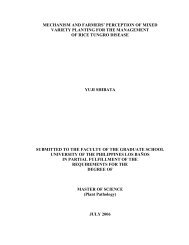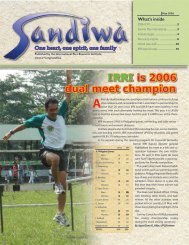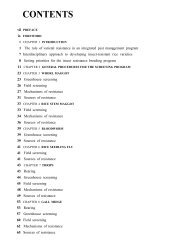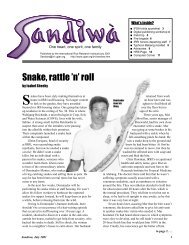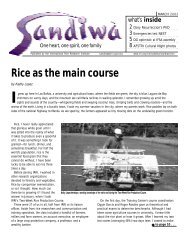Untitled - International Rice Research Institute
Untitled - International Rice Research Institute
Untitled - International Rice Research Institute
Create successful ePaper yourself
Turn your PDF publications into a flip-book with our unique Google optimized e-Paper software.
orange. On the reverse side of the agar plate, the<br />
colony looks azonated and yellowish brown. At 21 °C<br />
under alternating 12-h NUV light and 12-h darkness,<br />
colonies are restricted in growth and attain a 3.96-cm<br />
diam in 15 d. They are azonated, plane, velvety with<br />
even to slight sinuate margins, pale orange, and<br />
moisture is produced with age. The colony on the<br />
reverse side of the agar plate appears azonated and<br />
yellowish brown. At 28 °C under alternating 12-h<br />
fluorescent light and 12-h darkness, colonies are restricted<br />
in growth and attain a 4.23-cm diam in 15 d.<br />
They are zonated, plane, velvety with sinuate margins,<br />
and pale orange. On the reverse side of the agar<br />
plate, the colony appears slightly zonated and yellowish<br />
brown.<br />
Colonies on PSA at ART (28–30 °C) are restricted<br />
in growth and attain a 4.80-cm diam in 15 d.<br />
They are slightly zonated, slightly felted with sinuate<br />
margins, and pale orange. The colony on the reverse<br />
side of the agar plate appears slightly zonated and<br />
pale yellow-orange. At 21 °C under alternating 12-h<br />
NUV light and 12-h darkness, colonies are restricted<br />
in growth and attain a 4.21-cm diam in 15 d. They<br />
are azonated, plane, slightly velvety, with a few<br />
slight radial furrows, sinuate margins, and pale orange.<br />
The colony appears azonated, with a few radial<br />
wrinkles and pale yellow-orange on the reverse<br />
side of the agar plate. At 28 °C under alternating 12-h<br />
fluorescent light and 12-h darkness, colonies are restricted<br />
in growth and attain a 4.05-cm diam in 15 d.<br />
They are slightly zonated, slightly felted with a few<br />
slight radial furrows in some plates, with slightly sinuate<br />
to even margins, and pale orange; moisture is<br />
produced with age. The colony appears slightly zonated<br />
with a few slight radial wrinkles and pale yellow-orange<br />
on the reverse side of the agar plate.<br />
Colonies on MEA at ART (28–30 °C) are restricted<br />
in growth and attain a 4.84-cm diam in 15 d.<br />
They are slightly zonated, plane, velvety, and pale<br />
orange. The colony appears slightly zonated and dull<br />
orange with pale yellow-orange margins on the reverse<br />
side of the agar plate. At 21 °C under alternating<br />
12-h NUV light and 12-h darkness, colonies are<br />
restricted in growth and attain a 4.37-cm diam in 15<br />
d. They are zonated, felted with slight sinuate margins,<br />
and pale orange. On the reverse side of the agar<br />
plate, the colony appears azonated and dull orange<br />
with pale yellow-orange margins. At 28 °C under<br />
alternating 12-h fluorescent light and 12-h darkness,<br />
colonies are restricted in growth and attain a 4.47-cm<br />
diam in 15 d. They are plain to felted, zonated at the<br />
center, and become azonated toward the margins,<br />
with slight radial furrows and slight sinuate margins.<br />
Colonies are pale orange and whitish toward the margins.<br />
On the reverse side of the agar plate, the colony<br />
appears zonated with a few radial wrinkles and dull<br />
orange with pale yellow-orange margins.<br />
Seedborne fungi causing grain and inflorescence diseases in rice<br />
Curvularia sp.<br />
Disease caused: black kernel<br />
a. Symptoms<br />
Black discoloration on grains.<br />
b. Occurrence/distribution<br />
Curvularia sp. is frequently isolated from discolored<br />
rice grains. Several species have been reported<br />
on rice from different countries (Fig. 38),<br />
but C. lunata and C. geniculata are the most common<br />
ones.<br />
c. Importance in crop production<br />
Curvularia sp. causes little or no yield loss under<br />
normal rice production situations. Infected grains,<br />
after being polished, may produce black kernels,<br />
thus reducing their market value.<br />
Detection on seed<br />
a. Incubation period on blotter<br />
On blotters incubated under NUV light at 21 °C,<br />
the fungus can be observed growing on rice seed<br />
7 d after seeding. The detection frequency is<br />
about 70.6% on seeds coming from different regions<br />
(Fig. 39a,b).<br />
b. Habit character<br />
Aerial mycelia are scanty or absent; if present,<br />
they are light brown to brown with abundant<br />
branching. Conidiophores are solitary or in groups;<br />
dark brown; straight, sometimes bent; simple;<br />
arising directly from the seed surface. Conidia are<br />
borne more or less at the tip in a whorl or in thick<br />
panicles (Fig. 40a-c).<br />
38



